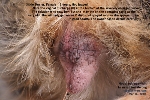|
Toa Payoh Vets Clinical
Research
Making veterinary surgery alive
to a veterinary student studying in Australia
using real case studies and pictures |
|
Why is my old female dog having
more diarrhoea episodes?
Dr Sing Kong Yuen,
BVMS (Glasgow), MRCVS
18 March, 2010
|
Hyperestrogenism in the old female
dog. What is the solution?
Spaying.
But this is now a high-anaesthetic
risk case as the dog is over 8
years old. So, the owner is in a
dilemma. To wait or not? |
 |
No endocrine alopecia. Excellent
skin and coat due to a high supply
of the female hormone, estrogen
|
|
|
|
 |
Blood-tinged vaginal discharge can
be seen if you check carefully |
|
The complaint is increasing bouts
of dark-coloured
diarrhoea from once a month to
more frequent once a week |
HYPERESTROGENISM
"My dog has diarrhoea once a month for the past 4
months," the man in his 30s said. "Now, she has
diarrhoea more than once in 2 weeks." There was no
change in her diet. This dog looked so much younger
than her 13 years. Her heart sounds were normal and
she had no loss of appetite. What was the cause of her
increasing frequency of diarrhoea? Was this a simple
case of gastro-enteritis?
Hyperestrogenism
A general examination from head to toe and up to below
is best for any case. "The vulva is abnormally large,
around 10X the normal size," I turned the dog upside
down so that the man could see what I meant. "There is
a slight pinkish mucoid vaginal discharge. She may be
having pyometra (infection of the womb and/or urinary
tract infection. Due to her continual licking of the
vaginal discharge over several days, her stomach and
intestines could be infected. She then suffers from
diarrhoea from once a month to more frequently when
the discharge persists."
"Your dog is likely to have ovarian cysts or tumours.
Excessive estrogen, a female hormone is produced
making the vulva grow so big. And also the womb
tissues could be degenerated and become cystic,
leading to womb infection called pyometra."
The man in his late 30s seemed convinced. "What to do
now?"
The solution is simple. A spay. But this dog is old.
Although she is healthy on the surface, she may die on
the operating table during anaesthesia and surgery.
This is the type of situation I dread. If she had been
spayed when she was young, this problem would not
exist. But now she needed to be spayed or her health
would deteriorate with time. "There is a possibility
of her dying on the operating table," I forewarned the
owner. "Talk to your wife. The chances are 50:50 for
your dog, based on her general good health externally.
If she survives, she may live to 20 years old. If not,
she will be gone on the day of the operation."
Blood tests and X-rays would be useful but they would
cost more. They would not alter the downhill progress
of the adverse effects of the Hyperestrogenism. I sent
the home with antibiotics. Spay your female dog when
she is young or seek veterinary advice when she has
abnormal enlargement of her private parts.
This case appeared to be a simple case of
gastro-enteritis but if you review the history and
check the signs and symptoms carefully, it is more
likely that the primary cause is Hyperestrogenism. So,
giving antibiotics would resolve the problem for some
time. Buying time for the old companion.
More Singapore small breed pet dogs are living past 10
years of age. The owners must be proactive and they
really have to spend time checking them for any
abnormal tumours and discharges. Spaying is one way
but not every owner wants their female dogs spayed. A
health check annually or more would have been best, if
you want your old friend to live longer.
 TIPS
FOR VET STUDENTS TIPS
FOR VET STUDENTS
Hyperestrogenism in female dogs
High serum estrogens (estradiol, estriol and estrone).
Exogeneous Hyperestrogenism: All ages
associated with estrogen administration.
Endogenous Hyperestrogenism:
1. Ovarian follicular cysts -Young female dogs
2. Ovarian tumours mainly. Adrenal tumours? - Old
female dogs.
Signs include non-pruritic bilateral endocrine
alopecia, vulval enlargement, haematuria with
thrombocytopenia, nymphomania, being attractive to
male dogs and pyometra.
3. Blood test for high serum estrogen levels. This may
not be welcome by the owner due to economic reasons.
In the above case, the "diarrhoea" is likely to be the
dog licking and ingesting the infected vaginal
discharge from the womb. Spaying would be the solution
but the dog may die on the operating table as she is
aged. So, the owner has no solution actually.
If only this dog was spayed when she was young. But
who can predict the future? |
|
|
 Toa Payoh Vets Toa Payoh Vets
Clinical
Research |
|
|
Copyright ©
Asiahomes Internet
All rights reserved. Revised: March 18, 2010
Toa
Payoh Vets
| |
 TOA
PAYOH VETS
TOA
PAYOH VETS TOA
PAYOH VETS
TOA
PAYOH VETS